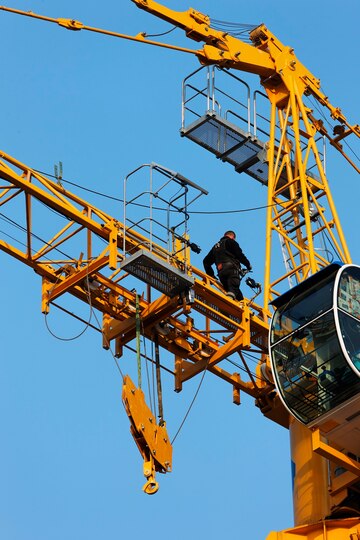To differentiate between a motorized hoist and a winch effectively when it comes to applications and their specific uses.
Understanding the Basics: Definitions and Primary Uses
Defining Motorized Hoists
Motorized cranes are operated machines crafted to elevate and descend loads with accuracy and effectiveness. Motorized hoists utilize power sources such, as motors which makes them appropriate for usage in settings needing heavy lifting. Generally, motorized hoists are utilized in tasks like building construction, factory production, and storage facilities. They provide flexibility for functions, like raising machinery or adjusting materials in confined areas.
What is a Winch?
Winches are tools mainly used to pull loads in either a vertical direction using a cable or rope instead of having a lifting system, for moving vertically like hoists do. The uses of winches include towing vehicles, cargo loading, and fishing due to their capability to provide strength when moving items horizontally or uphill. They are assets in industries due to their effectiveness, in transporting heavy objects across flat surfaces or inclines.
Key Differences in Functionality
There are distinctions, in the performance of a motorized hoist compared to a winch device. Motorized hoists are particularly effective for tasks involving lifting and lowering due to their ability to move vertically and their specialized lifting mechanisms. Conversely, winches are primarily used for pulling and creating tension with a focus on motion. The nature of the task typically determines the appropriate tool to use; utilizing a winch, for vertical lifting can result in inefficiencies and complications.
Technical Specifications of Motorized Hoists
When assessing motorized cranes thoroughly it’s crucial to examine their details.
Load Capacity and Lift Height
Motorized hoists are designed to handle weight limits and lifting distances, with precision and efficiency in mind. Electric hoists from companies, like Apollo are capable of bearing loads that can range from tons to hundreds of tons for ensuring safe operations effectively. Moreover, the lifting range can be significantly diverse to cater to the needs of settings. Reaching heights of dozens of meters. The presence of high-capacity hoists guarantees the handling of the most challenging tasks efficiently.
Power Sources: Electric, Pneumatic, and Hydraulic Options
Different types of hoists are powered by power sources, like hydraulic options available for use in various operations. Electric hoists are popular, for their ease of use and effectiveness while pneumatic ones are suitable where electricity is scarce. Hydraulic hoists excel in lifting loads. Can withstand tough conditions. Consider these advantages based.on your needs when choosing a power source for your hoist.
Safety Features and Mechanisms
Overload Protection
Safety is important when operating motorized hoists as they typically include safety features to prevent overloading risks by monitoring weight limits and limiting operation within capacities.
Emergency Stop Mechanisms
During emergencies, it’s important to act for safety reasons. Motorized hoists usually come equipped with emergency stop functions that let operators stop them immediately. This is vital, for keeping workplaces safe and following regulations.

Technical Specifications of Winches
Like cranes that run on engines and pulleys, there are technical requirements that determine how they are used.
Line Pull Capacity
Winches are known for their ability to pull an amount of weight that indicates the load they can manage when pulling something heavy. This capability can vary depending on the kind of winch and how it’s built. Selecting the winch that matches the pulling needs of the job is crucial to guarantee effectiveness and safety while carrying out tasks efficiently.
Types of Motors Used in Winches
Electric Motors
Electric winches use motors which makes them perfect, for places, with accessible power sources where operations are managed carefully and efficiently by many users because of their user-friendly nature and minimal maintenance requirements.
Hydraulic Motors
In contrast, to that point of view hydraulic motors are frequently utilized in winches used in demanding situations. Hydraulic winches deliver pulling power. Are ideal for sectors such, as construction or maritime transport where robust solutions are required. Each motor variant boasts its advantages based on the requirements of the working environment.
To sum up the discussion; although motorized hoists and winches possess features, to some extent; their diverse uses and specifications are tailored to different industrial needs. Understanding these distinctions can assist in selecting the appropriate equipment for a particular task.
Apollo provides a range of options, for businesses engaged in lifting operations with motorized hoists that prioritize safety and efficiency while ensuring durability well. They stand out in the industry by offering load capacities and safety features tailored to meet the requirements of various sectors. Whether your needs call for a powered hoist with customizable functions or a sturdy winch, for challenging projects. Apollo’s personalized solutions are designed to elevate your operational efficiency.
If you’re searching for lifting gear options take a look, at the selection of electric hoists offered by Apollo. They are designed with precision and top-notch performance, in mind.
Comparative Analysis: Motorized Hoists vs. Winches
Application Scenarios
Industrial Applications
In environments, like factories and manufacturing plants deciding between a motorized hoist and a winch depends largely on the type of lifting or pulling job at hand. Motorized hoists from companies like Apollo excel in lifting equipment and parts within factories. Their flexibility, in speed control and precise handling make them perfect for tasks that demand accuracy. On the side, winches are commonly used for loading and unloading tasks where the horizontal pulling strength is crucial. The winch’s capability to transport cargo effectively across distances is advantageous, for sectors, like shipping and logistics.
Construction Use Cases
When working on construction sites it’s important to have machinery, for lifting and moving tasks. Automated cranes are great for lifting beams or structural components due to their high lift height and weight capacities designed to handle building materials. Winches are essential for securing loads and towing construction equipment, over terrain. Every tool brings its benefits to a construction site by meeting the needs of the industry.
Performance Metrics: Speed, Precision, and Control
When looking at motorized hoists, versus winches in terms of performance metrics like speed and precision control play a role, in deciding which is best suited for tasks.
Motorized cranes are carefully controlled to enable precise lifting movements, for delicate tasks like handling loads in tight areas or carrying out intricate installations with precision and safety, in mind. Their ability to adjust speed and make fine adjustments ensures that loads can be navigated with care and efficiency.
Winches are sturdy when it comes to pulling tasks. They prioritize applying force over speed or positioning control capabilities Within their design limitations winches may not offer the best accuracy, for lifting objects short distances They shine in swiftly moving heavy loads between different points which proves valuable, in situations requiring frequent transportation.
Specific Products from Apollo That Illustrate These Differences
Apollo Motorized Hoists Overview
Apollo’s selection of motorized hoists showcases the practicality and characteristics that set them apart as an option, across industries.
Model XABC123 Features
The XABC123 model, by Apollo, showcases engineering capabilities by integrating a load capacity alongside smart lifting technology features. It boasts a lifting capacity of 5 tons ideal for challenging tasks. The structure incorporates a safety system with overload protection and emergency stops. In addition, this model excels in height adaptability enabling operations in confined areas that might pose challenges, for equipment.
Model YDEF456 Capabilities
A model release called YDEF456 by Apollo demonstrates their dedication to innovation through its lifting capacities, up to 10 tons, and unique dual-speed feature for quick lifting and lowering tasks. Its sturdy yet lightweight design makes it easy to transport and install at the worksite while ensuring safety with added security features to guarantee operations. Showcasing Apollo’s commitment to excellence and safety, in handling loads.
Apollo Winches Overview
Apollo also provides a variety of winches tailored to meet the requirements, for pulling and lifting in industries ensuring strength and dependability, in each model offered.
Model GHI789 Highlights
The GHI789 model showcases pulling strength by being able to handle loads of, up to 2 tons perfect for various material handling jobs in general settings! Thanks to its electric-powered system that ensures performance without the need for manual labor! Its compact structure enables it to maneuver easily in confined spaces—boosting its usefulness across work sites! Moreover, the incorporated safety measures guarantee the winch functions, within limits—lowering the chances of any mishaps.
Model JKL012 Specifications
The JKL012 is built for tasks. Can handle pulling weights of, up to 5 tons effectively. This winch model is crafted to withstand conditions. Can be used for extended periods without issues. By adjusting the gear system operators can easily manage the speed and force according to the job needs. Its sturdy build guarantees that the winch stays operational in challenging work environments making it a crucial tool, for construction and logistics experts.
Understanding the Safety Standards for Operation
Industry Standards for Motorized Hoists
Safety remains a critical concern within the usage of motorized hoists, given their frequent applications in lifting heavy loads. Industry standards dictate that motorized hoists must comply with regulations set by governing bodies, ensuring they operate within defined safety parameters. These regulations include safety features such as overload protection systems that help prevent accidents and equipment failure, securing both personnel and materials being lifted.
Compliance Requirements for Winches
For winches, compliance standards are equally important, especially in industries such as shipping and construction, where heavy loads are the norm. Winches must meet specifications that govern their line pull capacities and associated safety mechanisms. Regular maintenance checks and adherence to operational guidelines help maintain safe handling practices. By complying with these standards, businesses can ensure their operations remain safe and efficient, mitigating risk and enhancing productivity.
In summary, deciding between a motorized hoist and a winch hinges on understanding their various applications, functionalities, and strengths. Apollo’s comprehensive line of motorized hoists and winches addresses the needs of professionals across industries, providing customized solutions catered to specific operational demands. When considering your next industrial lifting or pulling challenge, Apollo stands ready to equip you with the tools necessary for success.

